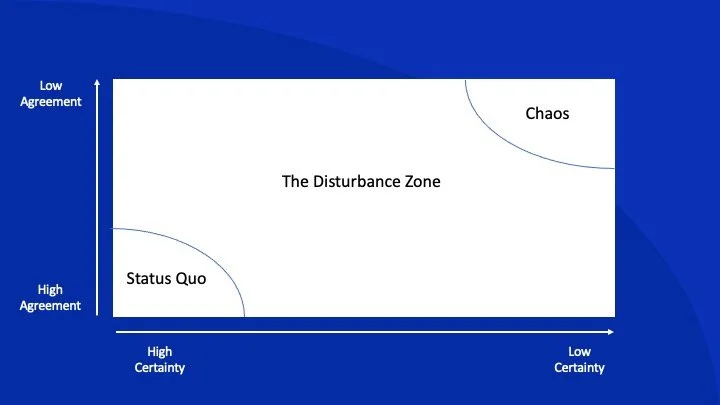Creating a Disturbance
I find lots of my work with business leaders ends up being about problems making real change happen. Organisations thrive on certainty and consensus, which reduce anxiety and create routines, habits and rituals. This becomes what is often described as “the way things are done round here”, the status quo, or as I like to provoke “addiction to a winning formula”. All of which creates a feeling of stuckness, driven by fear of the unknown and the risk of being unpopular. It’s at times like this I’m grateful to Ralph Stacey for creating the disturbance matrix.
When former Nokia CEO, Stephen Elop, famously said “we did nothing wrong, but somehow we lost” he probably didn’t realise he was making himself something of a standard bearer for the perils of being addicted to a winning formula. In the 90s and early 2000s Nokia was flying high globally. In the UK it had about 70% market share of the exponentially-fast-growing mobile phone market. Nokia’s attention stayed focused on the recipe that had served so well; smaller devices, larger batteries, reduced prices. By the time Apple, and then Samsung, arrived on the scene, with their large, expensive, energy-sapping smartphones, the writing was on the wall for Nokia. The company was unwilling/unable to step outside its status quo and challenge it’s own willing formula.
I often don’t know whether it is fear or complacency, or both, that creates stuckness but I do know that the word in the top right hand corner of the matrix, chaos, casts a large shadow. Companies (and people) who are strongly addicted to their winning formula don’t see a disturbance zone; they perceive any step away from the status quo as opening the door to chaos. This is where anxiety is born, which is where the work of change starts.
Companies that get stuck in the bottom left hand corner of the disturbance matrix manufacture certainty and agreement. The five year business plan is a classic example. How much time and effort is put into the process of painting a sure and certain picture of the future that everyone signs off on? What purpose does it really serve? If you say it helps prioritise decision making then I agree. But is that really what’s going on? In the fast-changing, post-industrial times we work in, how much of this is really about calming anxiety and making people feel better. Which in turn maintains ‘the way things are around here’ and keeps the firm stuck in the status quo. When was the last time your organisation pulled out a business plan from five years ago and evaluated it or used it to learn something?
I use the disturbance matrix mostly in team or group environments. We are generally in a conversation about what change they would like to see in their organisation. I usually map the matrix out on the floor with masking tape, as big as the room allows. I ask them to stand in the status quo corner and describe ‘the way things are’ right now. If they’re not going to be weirded out I ask them to close their eyes and really experience the status quo. I ask them how it feels. Then I ask them to make a step out toward the change they want them to see. It’s sometimes a bold step or two, often a tentative shuffle. I ask them to visualise what the step means (there is no need for any of this to be shared with the rest of the group, although they often want to later). I ask them how they feel. We work with whatever reaction they are having. And so it proceeds, helping participants work on the disturbance they are looking to cause and what it will require of them.
The status quo has a strong gravitational pull. Standing apart from the culture, the norm, ‘the way things are round here’ requires courage and then the ability to manage anxiety. The sometimes overwhelming temptation is to retreat and so I often ask something like ‘what do you need in order to stay longer in the disturbance zone?’. They often find unexpected answers. Sometimes they need support from others in the room who are watching and I might ask that person to join them. All the time the disturbance matrix is giving them an embodied, felt sense of what it will require and be like to cause the change they want to see on their organisation.
If/when they have resourced themselves and managed their anxiety I might ask what a further step away from the status quo toward chaos might look like. Each step represents increasing uncertainty and less potential agreement. By the time we finish, the participant has some solid ideas for action and, more importantly, an experience of themselves in action. It works. And it can be done on-line was well by asking participants to draw the matrix and then place their hand in the various zones as they close their eyes and visualise the status quo, the change, the anxiety and the resources.
This model does not just apply to organisations. Let’s face it, we are all creatures of habit, addicted to our own ‘ways of doing things’. We may not realise it but we can be just as stuck as complex organisations. We don’t resign from jobs we hate because we are afraid of what might happen next. We don’t suggest perhaps a night out without alcohol because we are not sure others will agree. We sleep on the same side of the bed, wherever we are. We have a ‘right’ way of stacking a dishwasher. We vote for the people we always vote for. None of this is wrong. But how much is just a habit, that potentially no longer serves us? What would it take to make a step away from certainty and agreement into the disturbance zone? And how might you stay out there longer and go further?

